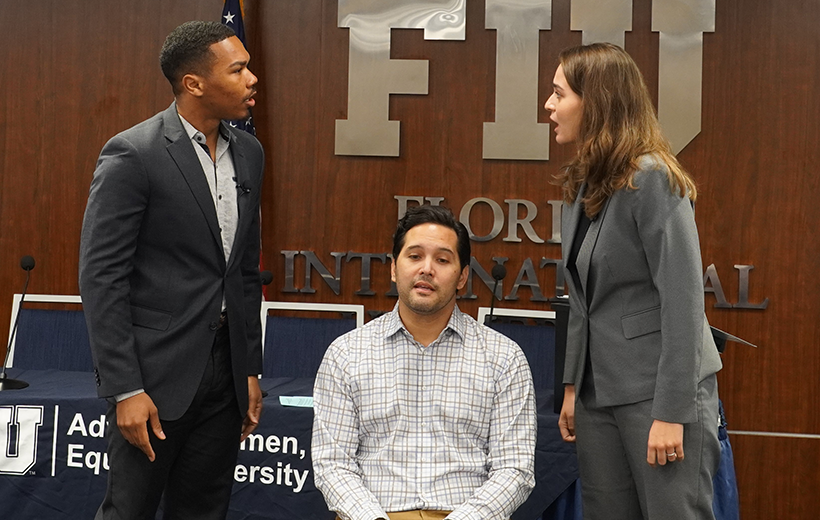Florida International University’s Bystander Leadership™ programme has collaborated with professional live theatre artists to increase awareness of gender and race bias among faculty through evidence-based practices
Bystander Leadership™ uses live theatre to teach participants the five steps of bystander intervention and leadership. The first two steps are to notice and interpret when workplace interactions reflect gender or race bias.
The US National Science Foundation ADVANCE program funds the AWED Theatre programme.
How can Applied Theatre foster interactive engagement?
To foster interactive engagement with these concepts, Jeffrey Steiger, the programme’s Creative Director, created and facilitates two theatre sketches which are performed by professional actors. Applied Theatre, the practice of using theatre-based techniques to foster reflection and action, is an engaging, non-threatening way to address controversial topics.
Applied theatre uses live theatre techniques as a visual tool to reflect issues of concern to communities, inviting a collective identification of problems. After examining the problems, participants are encouraged to participate on stage actively, utilising their agency to rehearse solutions as a catalyst for social change.
The first sketch, ‘The Joke’, focuses on a senior faculty member and a newly hired assistant professor conversing before other hiring committee members arrive. After establishing subtle power dynamics, the senior professor tells the assistant professor a joke. The ‘joke’ is crafted to align with the cultural norms and values commonly found in the United States/Western society and relies on negative stereotypes of women, Black people, and Hispanics.
Two performers depict the assistant professor’s inner ‘Greek chorus’, debating whether to go along with the joke and gain admission to the ‘boys club’ or to do the right thing and object to these stereotypes. Steiger facilitates a dialogue following the scenario that invites attendees to share their inner ‘Greek chorus,’ unpacking the often unsaid forces that deter or encourage action.
The second sketch, Faculty Mentoring Faculty, portrays a senior male providing critical and discouraging feedback to a junior woman faculty concerning her performance to date.
In the post-performance discussion, observers identify the issues of gender, power, and privilege that defined the interaction and discuss possible interventions. Steiger also guides participants to reflect on how the junior man or woman might perceive the situation and to identify indicators of implicit bias, as well as to consider the difference between intent versus impact (expressions of bias may not be intentional, but even so, the actions may harm women and minorities).
The theatre component of the workshop prepares participants to take the following three steps in Bystander intervention:
- Lead by deciding to say or do something;
- Decide what to do; and
- Act.
The rest of the programme includes skills training concerning various interventions that could be used to increase inclusion.
The Bystander programme indicates successful results
Of the more than 800 faculty that have attended the AWED Theatre programme for the Bystander LeadershipTM Workshop, 97% indicated that the live theatre performances enhance their understanding of the issues presented. 100% indicated that the facilitator effectively encouraged discussion.
Evidence collected three months after participating in the program revealed that attendance increased faculty members’ awareness of bias, their confidence to intervene, and their actions to intervene in observed instances of bias or exclusion.
Other topics that these live theatre sketch address include addressing burnout in medicine, sexual harassment prevention, equity in tenure and promotion, equity in the faculty search process, and the history of engineering education.
Five Days to Friday is a one-act play focusing on burnout in medicine and has been performed internationally and nationally at more than fifty medical schools or conferences and at the National Academies of Science, Engineering and Medicine. The play was written and directed by Steiger and choreographed by Peter Sparling, José Limón Dance Company and principal dancer with Martha Graham Dance Company.
Many AWED Theatre performances have been successfully offered in live and Zoom formats. Information about how to arrange a theatre performance is available at https://awedtheater.fiu.edu

This work is licensed under Creative Commons Attribution-NonCommercial-NoDerivatives 4.0 International.


